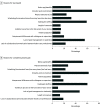Prevalence of and Factors Associated With Nurse Burnout in the US
- PMID: 33538823
- PMCID: PMC7862989
- DOI: 10.1001/jamanetworkopen.2020.36469
Prevalence of and Factors Associated With Nurse Burnout in the US
Erratum in
-
Error in Sample Sizes.JAMA Netw Open. 2021 Mar 1;4(3):e215373. doi: 10.1001/jamanetworkopen.2021.5373. JAMA Netw Open. 2021. PMID: 33724384 Free PMC article. No abstract available.
-
Error in Funding/Support.JAMA Netw Open. 2023 Apr 3;6(4):e2312593. doi: 10.1001/jamanetworkopen.2023.12593. JAMA Netw Open. 2023. PMID: 37097638 Free PMC article. No abstract available.
Abstract
Importance: Clinician burnout is a major risk to the health of the US. Nurses make up most of the health care workforce, and estimating nursing burnout and associated factors is vital for addressing the causes of burnout.
Objective: To measure rates of nurse burnout and examine factors associated with leaving or considering leaving employment owing to burnout.
Design, setting, and participants: This secondary analysis used cross-sectional survey data collected from April 30 to October 12, 2018, in the National Sample Survey of Registered Nurses in the US. All nurses who responded were included (N = 50 273). Data were analyzed from June 5 to October 1, 2020.
Exposures: Age, sex, race and ethnicity categorized by self-reported survey question, household income, and geographic region. Data were stratified by workplace setting, hours worked, and dominant function (direct patient care, other function, no dominant function) at work.
Main outcomes and measures: The primary outcomes were the likelihood of leaving employment in the last year owing to burnout or considering leaving employment owing to burnout.
Results: The weighted sample of 50 273 respondents (representing 3 957 661 nurses nationally) was predominantly female (90.4%) and White (80.7%); the mean (SD) age was 48.7 (0.04) years. Among nurses who reported leaving their job in 2017 (n = 418 769), 31.5% reported burnout as a reason, with lower proportions of nurses reporting burnout in the West (16.6%) and higher proportions in the Southeast (30.0%). Compared with working less than 20 h/wk, nurses who worked more than 40 h/wk had a higher likelihood identifying burnout as a reason they left their job (odds ratio, 3.28; 95% CI, 1.61-6.67). Respondents who reported leaving or considering leaving their job owing to burnout reported a stressful work environment (68.6% and 59.5%, respectively) and inadequate staffing (63.0% and 60.9%, respectively).
Conclusions and relevance: These findings suggest that burnout is a significant problem among US nurses who leave their job or consider leaving their job. Health systems should focus on implementing known strategies to alleviate burnout, including adequate nurse staffing and limiting the number of hours worked per shift.
Conflict of interest statement
Figures



References
-
- National Academies Press. Taking action against clinician burnout: a systems approach to professional well-being. National Academies Press; 2019. Accessed August 14, 2020. https://www.nap.edu/download/25521 - PubMed
-
- United States Department of Labor Bureau of Labor Statistics Employment by detailed occupation. Published September 1, 2020. Accessed September 2, 2020. https://www.bls.gov/emp/tables/emp-by-detailed-occupation.htm
-
- United States Department of Labor Bureau of Labor Statistics Occupational outlook handbook: registered nurses. Published September 1, 2020. Accessed September 2, 2020. https://www.bls.gov/ooh/healthcare/registered-nurses.htm
-
- Institute of Medicine (US) Committee on the Work Environment for Nurses and Patient Safety ; Page A, ed. Keeping Patients Safe: Transforming the Work Environment of Nurses. National Academies Press; 2004. Accessed July 23, 2020. https://www.ncbi.nlm.nih.gov/books/NBK216190/ - PubMed
Publication types
MeSH terms
Grants and funding
LinkOut - more resources
Full Text Sources
Other Literature Sources
Medical
Miscellaneous

